Analysis of the film on Engelbart´s demo
A Research Center for Augmenting Human Intellect, 1968. - Videotape copy of the original film footage from Engelbart's 90-minute multimedia presentation of his work at the Fall Joint Computer Conference in San Francisco, CA, December 9, 1968.
All the sources I have got seem to agree on the fact that Douglas C. Engelbart's demo was of a very important impact on the history of human-computer interaction. Many like to remind that it was the "debut of the mouse, hypermedia, on-screen video teleconferencing, shared white-boards, outline processing, windows, etc."
In May 1962 Douglas C. Engelbart writes to Vannevar Bush and tells how much Bush's vision described in the article "As We May Think" (1945) as influenced his work. He asks the permission to add Bush's article to a report he is writing on his own work focusing on "increasing the individual human's intellectual effectiveness". Engelbart finishes his letter as fellow:
"(My report) is more than just a report to a government agency. For me it is more the public debut of a dream, and the overdue birth attests to my emotional involvement."
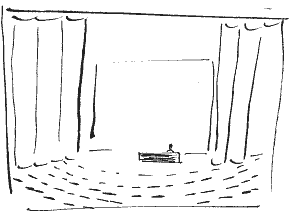 Is
this why I like to think of this demo also as an emotionally charged event?
This Demo is considered as "the mother of all demos". It has been filmed
and the film eventually transferred to video format transmits us through
the years Engelbart's exact words and actions during the demo as well
as its atmosphere. I believe the film of the demo is in itself a very
special document. Not only for the information it is providing us with,
but also as an object through which we can understand the emotional influence
of this "mother of the demos", over the years.
Is
this why I like to think of this demo also as an emotionally charged event?
This Demo is considered as "the mother of all demos". It has been filmed
and the film eventually transferred to video format transmits us through
the years Engelbart's exact words and actions during the demo as well
as its atmosphere. I believe the film of the demo is in itself a very
special document. Not only for the information it is providing us with,
but also as an object through which we can understand the emotional influence
of this "mother of the demos", over the years.
No one mentions the director of the film. I haven't found anything telling about the film in it self, in technical terms or analytical terms. (During the projection I noticed that it was edited by Saul Greenberg: does this mean the video only was edited by him?) From the nature of the image I can tell it was made on celluloid and it also uses cinema techniques for superposition of images and fade-ins.
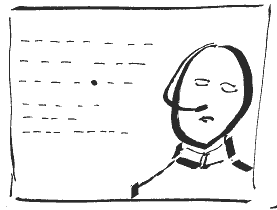 On
the bases of what I remember from a unique screening of the video, there
are a few things I would like to underline. On a general level I found
this film very enthralling. I was surprised to see how the film of a conference
could avoid being visually boring, how it's making out of a static situation
(people lecturing sitting behind a table) something alive and almost dramatic
at times, how multiple distinct spaces are visualized in the frame of
one same screen.
On
the bases of what I remember from a unique screening of the video, there
are a few things I would like to underline. On a general level I found
this film very enthralling. I was surprised to see how the film of a conference
could avoid being visually boring, how it's making out of a static situation
(people lecturing sitting behind a table) something alive and almost dramatic
at times, how multiple distinct spaces are visualized in the frame of
one same screen.
The first shot shows an impressive room where the demo will happen, from the point of view of the audience (fig 1). The set is monumental: a huge white screen between high and heavy curtains, thousand seats facing the small table where lies Engelbart's equipments. There is silence. There is space for an historic event. Engelbart starts to speak with a calm and gentle voice amplified through the loud speakers. In this monumental set his voice is touching: it is the only thing that refers to a human scale.
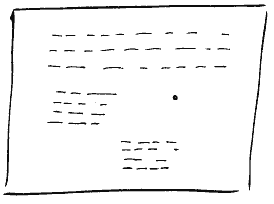 The
second shot shows a close up of Englebart speaking. The choice of a low
angle view, and the strange but elegant microphone attached to his face
makes contributes to emphasize Engelbart's speech and at the same time
refers to the future (the microphone looks like a science fiction film
props).
The
second shot shows a close up of Englebart speaking. The choice of a low
angle view, and the strange but elegant microphone attached to his face
makes contributes to emphasize Engelbart's speech and at the same time
refers to the future (the microphone looks like a science fiction film
props).
The composition of this shot is curiously balanced with Engelbarts' face on the very right part of the frame leaving the rest of the image completely white, like empty.
Soon this emptiness is filled with the inscriptions appearing on the computer screen projected on the wall (fig. 2). The viewer can fellow the interaction between Engelbart and his machine at the same time he/she sees him speaking.
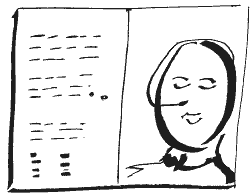 This
shot obtained by superposition of two images, operates as an introducer
to the world of the machine. The screen is not yet shown alone, either
is the computer it self. The friendly presence of Englebart's face in
the frame makes the situation human, though still impressive.
This
shot obtained by superposition of two images, operates as an introducer
to the world of the machine. The screen is not yet shown alone, either
is the computer it self. The friendly presence of Englebart's face in
the frame makes the situation human, though still impressive.
Later on (fig.3) the screen will be shown alone. At that moment the attention of the viewer is turned toward the pointer and it seems opportune to leave more space to the screen. It allows seeing more details supporting Engelbart's speech.
At some point and particularly during the demo of the video teleconference, the frame is divided in two parts (fig. 4) one dedicated to the computer screen, the other one to the speakers' faces. Some time the faces appear in a medaillion in the upper corners of the frame. These effects remind the way of sharing the frame of a screen nowadays for TV or Internet pages layout.
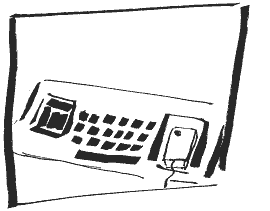 It's
only much later in the demo that the elements of the machine will be shown
in deep focus: meaning they are facing Engelbart in the space of the set.
The mouse and the results of its movements on the computer screen are
shown simultaneously in a divided frame (fig.5).The
keyboard with the chords and the mouse are shown in one global image (fig.6).
The viewer knows that those elements sit in front of the audience. Audience's
laughs and reaction can be heard but the people them selves are never
really shown. I find it very intriguing to see that with this film Engelbart
seems to speak directly to the viewer and at the same time every thing
shows how close to his audience the scientist has been able to be constantly,
by choosing everyday life examples in his demonstration, by joking, by
speaking very clearly, and looking at the audience, etc. I believe that
this film is a very successful and efficient demo film at a cinematographic
and dramatic level, impressing the emotional memory of any viewer.
It's
only much later in the demo that the elements of the machine will be shown
in deep focus: meaning they are facing Engelbart in the space of the set.
The mouse and the results of its movements on the computer screen are
shown simultaneously in a divided frame (fig.5).The
keyboard with the chords and the mouse are shown in one global image (fig.6).
The viewer knows that those elements sit in front of the audience. Audience's
laughs and reaction can be heard but the people them selves are never
really shown. I find it very intriguing to see that with this film Engelbart
seems to speak directly to the viewer and at the same time every thing
shows how close to his audience the scientist has been able to be constantly,
by choosing everyday life examples in his demonstration, by joking, by
speaking very clearly, and looking at the audience, etc. I believe that
this film is a very successful and efficient demo film at a cinematographic
and dramatic level, impressing the emotional memory of any viewer.
 Marianne
Decoster-Taivalkoski, Helsinki, October 2001.
Marianne
Decoster-Taivalkoski, Helsinki, October 2001.
<< back